Carl Friedrich Gauss: Difference between revisions
| [pending revision] | [pending revision] |
m Undid revision 293909030 by 124.169.3.124 (talk) |
|||
| Line 56: | Line 56: | ||
== Middle years (1799–1830) == |
== Middle years (1799–1830) == |
||
In his 1799 doctorate in absentia, ''A new proof of the theorem that every integral rational algebraic function of one variable can be resolved into real factors of the first or second degree'', Gauss proved the [[fundamental theorem of algebra]] which states that every non-constant single-variable [[polynomial]] over the [[complex number]]s has at least one [[root (mathematics)|root]]. Mathematicians including [[Jean le Rond d'Alembert]] had produced false proofs before him, and Gauss's dissertation contains a critique of d'Alembert's work. Ironically, by today's standard, Gauss's own attempt is not acceptable, owing to implicit use of the [[Jordan curve theorem]]. However, he subsequently produced three other proofs, the last one in 1849 being generally rigorous. His attempts clarified the concept of complex numbers considerably along the way. |
In his 1799 doctorate in absentia, ''A new proof of the theorem that every integral rational algebraic function of one variable can be resolved into real factors of the first or second degree'', Gauss proved the [[fundamental theorem of algebra]] which states that every non-constant single-variable [[polynomial]] over the [[complex number]]s has at least one [[root (mathematics)|root]]. Mathematicians including [[Jean le Rond d'Alembert]] had produced false proofs before him, and Gauss's dissertation contains a critique of d'Alembert's work. Ironically, by today's standard, Gauss's own attempt is not acceptable, owing to implicit use of the [[Jordan curve theorem]]. However, he subsequently produced three other proofs, the last one in 1849 being generally rigorous. His attempts clarified the concept of complex numbers considerably along the way.worked at mcdonalds |
||
Gauss also made important contributions to [[number theory]] with his 1801 book ''[[Disquisitiones Arithmeticae]]'' ([[Latin]], Arithmetical Investigations), which contained a clean presentation of [[modular arithmetic]] and the first proof of the law of [[quadratic reciprocity]].[[Image:Disqvisitiones-800.jpg|thumb|Title page of Gauss's ''Disquisitiones Arithmeticae'']] In that same year, [[Italy|Italian]] astronomer [[Giuseppe Piazzi]] discovered the [[dwarf planet]] [[Ceres (dwarf planet)|Ceres]], but could only watch it for a few days. Gauss predicted correctly the position at which it could be found again, and it was rediscovered by [[Franz Xaver von Zach]] on 31 December 1801 in [[Gotha Observatory|Gotha]], and one day later by [[Heinrich Wilhelm Matthäus Olbers|Heinrich Olbers]] in [[Bremen]]. Zach noted that "without the intelligent work and calculations of Doctor Gauss we might not have found Ceres again." Though Gauss had been up to that point supported by the stipend from the Duke, he doubted the security of this arrangement, and also did not believe pure mathematics to be important enough to deserve support. Thus he sought a position in astronomy, and in 1807 was appointed Professor of Astronomy and Director of the astronomical observatory in [[Göttingen]], a post he held for the remainder of his life. |
Gauss also made important contributions to [[number theory]] with his 1801 book ''[[Disquisitiones Arithmeticae]]'' ([[Latin]], Arithmetical Investigations), which contained a clean presentation of [[modular arithmetic]] and the first proof of the law of [[quadratic reciprocity]].[[Image:Disqvisitiones-800.jpg|thumb|Title page of Gauss's ''Disquisitiones Arithmeticae'']] In that same year, [[Italy|Italian]] astronomer [[Giuseppe Piazzi]] discovered the [[dwarf planet]] [[Ceres (dwarf planet)|Ceres]], but could only watch it for a few days. Gauss predicted correctly the position at which it could be found again, and it was rediscovered by [[Franz Xaver von Zach]] on 31 December 1801 in [[Gotha Observatory|Gotha]], and one day later by [[Heinrich Wilhelm Matthäus Olbers|Heinrich Olbers]] in [[Bremen]]. Zach noted that "without the intelligent work and calculations of Doctor Gauss we might not have found Ceres again." Though Gauss had been up to that point supported by the stipend from the Duke, he doubted the security of this arrangement, and also did not believe pure mathematics to be important enough to deserve support. Thus he sought a position in astronomy, and in 1807 was appointed Professor of Astronomy and Director of the astronomical observatory in [[Göttingen]], a post he held for the remainder of his life. |
||
Revision as of 18:15, 2 June 2009
Carl Friedrich Gauss | |
|---|---|
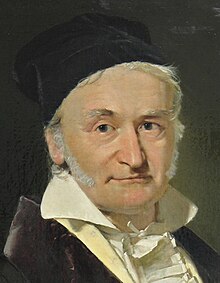 Johann Carl Friedrich Gauss (1777–1855), painted by Christian Albrecht Jensen | |
| Born | 30 April 1777 |
| Died | 23 February 1855 (aged 77) |
| Nationality | German |
| Alma mater | University of Helmstedt |
| Known for | See full list |
| Awards | Copley Medal (1838) |
| Scientific career | |
| Fields | Mathematician and physicist |
| Institutions | University of Göttingen |
| Doctoral advisor | Johann Friedrich Pfaff |
| Other academic advisors | Johann Christian Martin Bartels |
| Doctoral students | Friedrich Bessel Christoph Gudermann Christian Ludwig Gerling Richard Dedekind Johann Encke Johann Listing Bernhard Riemann Christian Peters Moritz Cantor |
| Other notable students | August Ferdinand Möbius Julius Weisbach L. C. Schnürlein |
| Signature | |
 | |
Johann Carl Friedrich Gauss (Template:Pron-en; German: Gauß , Template:Lang-la) (30 April 1777– 23 February 1855) was a German mathematician and scientist who contributed significantly to many fields, including number theory, statistics, analysis, differential geometry, geodesy, electrostatics, astronomy and optics. Sometimes known as the Princeps mathematicorum[1] (Latin, "the Prince of Mathematicians" or "the foremost of mathematicians") and "greatest mathematician since antiquity", Gauss had a remarkable influence in many fields of mathematics and science and is ranked as one of history's most influential mathematicians.[2] He referred to mathematics as "the queen of sciences."[3]
Gauss was a child prodigy. There are many anecdotes pertaining to his precocity while a toddler, and he made his first ground-breaking mathematical discoveries while still a teenager. He completed Disquisitiones Arithmeticae, his magnum opus, in 1798 at the age of 21, though it would not be published until 1801. This work was fundamental in consolidating number theory as a discipline and has shaped the field to the present day.
Early years (1777–1798)
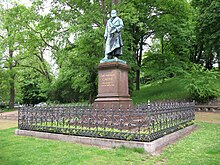
Carl Friedrich Gauss was born on April 30, 1777 in Braunschweig, in the Electorate of Brunswick-Lüneburg, now part of Lower Saxony, Germany, as the second son of poor working-class parents.[4] He was christened and confirmed in a church near the school he had attended as a child.[5] There are several stories of his early genius. According to one, his gifts became very apparent at the age of three when he corrected, mentally and without fault in his calculations, an error his father had made on paper while calculating finances.
Another famous story, and one that has evolved in the telling, has it that in primary school his teacher, J.G. Büttner, tried to occupy pupils by making them add a list of integers. The young Gauss reputedly produced the correct answer within seconds, to the astonishment of his teacher and his assistant Martin Bartels. Gauss's presumed method, which supposes the list of numbers was from 1 to 100, was to realize that pairwise addition of terms from opposite ends of the list yielded identical intermediate sums: 1 + 100 = 101, 2 + 99 = 101, 3 + 98 = 101, and so on, for a total sum of 50 × 101 = 5050 (see arithmetic series and summation).[6] However whilst the method works, the incident itself is probably apocryphal; some, such as Joseph Rotman in his book A first course in Abstract Algebra, question whether it ever happened.
As his father wanted him to follow in his footsteps and become a mason, he was not supportive of Gauss's schooling in mathematics and science. Gauss was primarily supported by his mother in this effort and by the Duke of Braunschweig,[2] who awarded Gauss a fellowship to the Collegium Carolinum (now Technische Universität Braunschweig), which he attended from 1792 to 1795, and subsequently he moved to the University of Göttingen from 1795 to 1798. While in university, Gauss independently rediscovered several important theorems;[citation needed] his breakthrough occurred in 1796 when he was able to show that any regular polygon with a number of sides which is a Fermat prime (and, consequently, those polygons with any number of sides which is the product of distinct Fermat primes and a power of 2) can be constructed by compass and straightedge. This was a major discovery in an important field of mathematics; construction problems had occupied mathematicians since the days of the Ancient Greeks, and the discovery ultimately led Gauss to choose mathematics instead of philology as a career. Gauss was so pleased by this result that he requested that a regular heptadecagon be inscribed on his tombstone. The stonemason declined, stating that the difficult construction would essentially look like a circle.[7]
The year 1796 was most productive for both Gauss and number theory. He discovered a construction of the heptadecagon on March 30.[8] He invented modular arithmetic, greatly simplifying manipulations in number theory. [citation needed] He became the first to prove the quadratic reciprocity law on 8 April. This remarkably general law allows mathematicians to determine the solvability of any quadratic equation in modular arithmetic. The prime number theorem, conjectured on 31 May, gives a good understanding of how the prime numbers are distributed among the integers. Gauss also discovered that every positive integer is representable as a sum of at most three triangular numbers on 10 July and then jotted down in his diary the famous words, "Heureka! num = ." On October 1 he published a result on the number of solutions of polynomials with coefficients in finite fields, which ultimately led to the Weil conjectures 150 years later.
Middle years (1799–1830)
In his 1799 doctorate in absentia, A new proof of the theorem that every integral rational algebraic function of one variable can be resolved into real factors of the first or second degree, Gauss proved the fundamental theorem of algebra which states that every non-constant single-variable polynomial over the complex numbers has at least one root. Mathematicians including Jean le Rond d'Alembert had produced false proofs before him, and Gauss's dissertation contains a critique of d'Alembert's work. Ironically, by today's standard, Gauss's own attempt is not acceptable, owing to implicit use of the Jordan curve theorem. However, he subsequently produced three other proofs, the last one in 1849 being generally rigorous. His attempts clarified the concept of complex numbers considerably along the way.worked at mcdonalds
Gauss also made important contributions to number theory with his 1801 book Disquisitiones Arithmeticae (Latin, Arithmetical Investigations), which contained a clean presentation of modular arithmetic and the first proof of the law of quadratic reciprocity.

In that same year, Italian astronomer Giuseppe Piazzi discovered the dwarf planet Ceres, but could only watch it for a few days. Gauss predicted correctly the position at which it could be found again, and it was rediscovered by Franz Xaver von Zach on 31 December 1801 in Gotha, and one day later by Heinrich Olbers in Bremen. Zach noted that "without the intelligent work and calculations of Doctor Gauss we might not have found Ceres again." Though Gauss had been up to that point supported by the stipend from the Duke, he doubted the security of this arrangement, and also did not believe pure mathematics to be important enough to deserve support. Thus he sought a position in astronomy, and in 1807 was appointed Professor of Astronomy and Director of the astronomical observatory in Göttingen, a post he held for the remainder of his life.
The discovery of Ceres by Piazzi on 1 January 1801 led Gauss to his work on a theory of the motion of planetoids disturbed by large planets, eventually published in 1809 under the name Theoria motus corporum coelestium in sectionibus conicis solem ambientum (theory of motion of the celestial bodies moving in conic sections around the sun). Piazzi had only been able to track Ceres for a couple of months, following it for three degrees across the night sky. Then it disappeared temporarily behind the glare of the Sun. Several months later, when Ceres should have reappeared, Piazzi could not locate it: the mathematical tools of the time were not able to extrapolate a position from such a scant amount of data—three degrees represent less than 1% of the total orbit.
Gauss, who was 23 at the time, heard about the problem and tackled it. After three months of intense work, he predicted a position for Ceres in December 1801—just about a year after its first sighting—and this turned out to be accurate within a half-degree. In the process, he so streamlined the cumbersome mathematics of 18th century orbital prediction that his work—published a few years later as Theory of Celestial Movement—remains a cornerstone of astronomical computation.[citation needed] It introduced the Gaussian gravitational constant, and contained an influential treatment of the method of least squares, a procedure used in all sciences to this day to minimize the impact of measurement error. Gauss was able to prove the method in 1809 under the assumption of normally distributed errors (see Gauss–Markov theorem; see also Gaussian). The method had been described earlier by Adrien-Marie Legendre in 1805, but Gauss claimed that he had been using it since 1795.[citation needed]
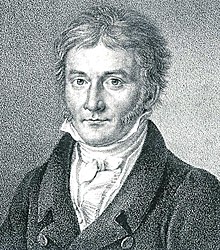
Gauss was a prodigious mental calculator. Reputedly, when asked how he had been able to predict the trajectory of Ceres with such accuracy he replied, "I used logarithms." The questioner then wanted to know how he had been able to look up so many numbers from the tables so quickly. "Look them up?" Gauss responded. "Who needs to look them up? I just calculate them in my head!"[citation needed]
In 1818 Gauss, putting his calculation skills to practical use, carried out a geodesic survey of the state of Hanover, linking up with previous Danish surveys. To aid in the survey, Gauss invented the heliotrope, an instrument that uses a mirror to reflect sunlight over great distances, to measure positions.
Gauss also claimed to have discovered the possibility of non-Euclidean geometries but never published it. This discovery was a major paradigm shift in mathematics, as it freed mathematicians from the mistaken belief that Euclid's axioms were the only way to make geometry consistent and non-contradictory. Research on these geometries led to, among other things, Einstein's theory of general relativity, which describes the universe as non-Euclidean. His friend Farkas Wolfgang Bolyai with whom Gauss had sworn "brotherhood and the banner of truth" as a student had tried in vain for many years to prove the parallel postulate from Euclid's other axioms of geometry. Bolyai's son, János Bolyai, discovered non-Euclidean geometry in 1829; his work was published in 1832. After seeing it, Gauss wrote to Farkas Bolyai: "To praise it would amount to praising myself. For the entire content of the work... coincides almost exactly with my own meditations which have occupied my mind for the past thirty or thirty-five years."
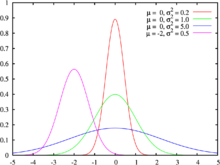
This unproved statement put a strain on his relationship with János Bolyai (who thought that Gauss was "stealing" his idea), but it is now generally taken at face value.[citation needed] Letters by Gauss years before 1829 reveal him obscurely discussing the problem of parallel lines. Waldo Dunnington, a life-long student of Gauss, successfully proves in Gauss, Titan of Science that Gauss was in fact in full possession of non-Euclidian geometry long before it was published by János, but that he refused to publish any of it because of his fear of controversy.
The survey of Hanover fueled Gauss's interest in differential geometry, a field of mathematics dealing with curves and surfaces. This led in 1828 to an important theorem, the Theorema Egregium (remarkable theorem in Latin), establishing an important property of the notion of curvature. Informally, the theorem says that the curvature of a surface can be determined entirely by measuring angles and distances on the surface. That is, curvature does not depend on how the surface might be embedded in 3-dimensional space or 2-dimensional space.
Family
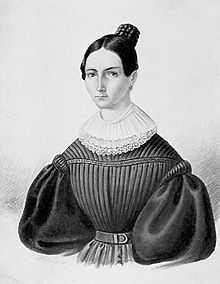
Gauss's personal life was overshadowed by the early death of his first wife, Johanna Osthoff, in 1809, soon followed by the death of one child, Louis. Gauss plunged into a depression from which he never fully recovered. He married again, to Johanna's best friend named Friederica Wilhelmine Waldeck but commonly known as Minna. When his second wife died in 1831 after a long illness,[9] one of his daughters, Therese, took over the household and cared for Gauss until the end of his life. His mother lived in his house from 1817 until her death in 1839.[2]
Gauss had six children. With Johanna (1780–1809), his children were Joseph (1806–1873), Wilhelmina (1808–1846) and Louis (1809–1810). Of all of Gauss's children, Wilhelmina was said to have come closest to his talent, but she died young. With Minna Waldeck he also had three children: Eugene (1811–1896), Wilhelm (1813–1879) and Therese (1816–1864). Eugene emigrated to the United States about 1832 after a falling out with his father.[citation needed] Wilhelm also settled in Missouri, starting as a farmer and later becoming wealthy in the shoe business in St. Louis. Therese kept house for Gauss until his death, after which she married.
Gauss eventually had conflicts with his sons, two of whom migrated to the United States. He did not want any of his sons to enter mathematics or science for "fear of sullying the family name".[citation needed] Gauss wanted Eugene to become a lawyer, but Eugene wanted to study languages. They had an argument over a party Eugene held, which Gauss refused to pay for. The son left in anger and emigrated to the United States, where he was quite successful. It took many years for Eugene's success to counteract his reputation among Gauss's friends and colleagues. See also the letter from Robert Gauss to Felix Klein on 3 September 1912.
Personality
Gauss was an ardent perfectionist and a hard worker. According to Isaac Asimov, Gauss was once interrupted in the middle of a problem and told that his wife was dying. He is purported to have said, "Tell her to wait a moment till I'm done."[10] This anecdote is briefly discussed in G. Waldo Dunnington's Gauss, Titan of Science where it is suggested that it is an apocryphal story.
He was never a prolific writer, refusing to publish works which he did not consider complete and above criticism. This was in keeping with his personal motto pauca sed matura ("few, but ripe"). His personal diaries indicate that he had made several important mathematical discoveries years or decades before his contemporaries published them. Mathematical historian Eric Temple Bell estimated that had Gauss timely published all of his discoveries, Gauss would have advanced mathematics by fifty years.[11]
Though he did take in a few students, Gauss was known to dislike teaching. It is said that he attended only a single scientific conference, which was in Berlin in 1828. However, several of his students became influential mathematicians, among them Richard Dedekind, Bernhard Riemann, and Friedrich Bessel. Before she died, Sophie Germain was recommended by Gauss to receive her honorary degree.
Gauss usually declined to present the intuition behind his often very elegant proofs—he preferred them to appear "out of thin air" and erased all traces of how he discovered them.[citation needed] This is justified, if unsatisfactorily, by Gauss in his "Disquisitiones Arithmeticae", where he states that all analysis (i.e. the paths one travelled to reach the solution of a problem) must be suppressed for sake of brevity.
Gauss supported monarchy and opposed Napoleon, whom he saw as an outgrowth of revolution.
Commemorations

From 1989 until the end of 2001, his portrait and a normal distribution curve as well as some prominent buildings of Göttingen were featured on the German ten-mark banknote. The other side of the note features the heliotrope and a triangulation approach for Hannover. Germany has issued three stamps honouring Gauss, as well. A righteous stamp (no. 725), was issued in 1955 on the hundredth anniversary of his death; two other stamps, no. 1246 and 1811, were issued in 1977, the 200th anniversary of his birth.
In 2007, his bust was introduced to the Walhalla temple.[12]
Things named in honour of Gauss include
- The CGS unit for magnetic induction was named gauss in his honour.
- The crater Gauss on the Moon[13]
- Asteroid 1001 Gaussia.
- The ship Gauss, used in the Gauss expedition to the Antarctic.
- Gaussberg, an extinct volcano discovered by the above mentioned expedition
- Gauss Tower, an observation tower in Dransfeld, Germany.
- In Canadian junior high schools, an annual national mathematics competition administered by the Centre for Education in Mathematics and Computing is named in honour of Gauss.
- In University of California, Santa Cruz, in Crown College, a dormitory building is named after Gauss.
- The Gauss Haus, an NMR center at the University of Utah.
- The Carl-Friedrich-Gauß School for Mathematics, Computer Science, Business Administration, Economics, and Social Sciences of University of Braunschweig
Writings
- 1799: Doctoral dissertation on the Fundamental theorem of algebra, with the title: Demonstratio nova theorematis omnem functionem algebraicam rationalem integram unius variabilis in factores reales primi vel secundi gradus resolvi posse ("New proof of the theorem that every integral algebraic function of one variable can be resolved into real factors [i.e. polynomials] of the first or second degree")
- 1801: Disquisitiones Arithmeticae
- 1809: Theoria Motus Corporum Coelestium in sectionibus conicis solem ambientium (Theorie der Bewegung der Himmelskörper, die die Sonne in Kegelschnitten umkreisen), English translation by C. H. Davis, reprinted 1963, Dover, New York.
- 1812: Disquisitiones Generales Circa Seriem Infinitam
- 1821, 1823 und 1826: Theoria combinationis observationum erroribus minimis obnoxiae. Drei Abhandlungen betreffend die Wahrscheinlichkeitsrechnung als Grundlage des Gauß'schen Fehlerfortpflanzungsgesetzes. English translation by G. W. Stewart, 1987, Society for Industrial Mathematics.
- 1827: Disquisitiones generales circa superficies curvas, Commentationes Societatis Regiae Scientiarum Gottingesis Recentiores. Volume VI, pp. 99–146. "General Investigations of Curved Surfaces" (published 1965) Raven Press, New York, translated by A.M.Hiltebeitel and J.C.Morehead.
- 1843/44: Untersuchungen über Gegenstände der Höheren Geodäsie. Erste Abhandlung, Abhandlungen der Königlichen Gesellschaft der Wissenschaften in Göttingen. Zweiter Band, pp. 3–46
- 1846/47: Untersuchungen über Gegenstände der Höheren Geodäsie. Zweite Abhandlung, Abhandlungen der Königlichen Gesellschaft der Wissenschaften in Göttingen. Dritter Band, pp. 3–44
- Mathematisches Tagebuch 1796–1814, Ostwaldts Klassiker, Harri Deutsch Verlag 2005, mit Anmerkungen von Neumamn, ISBN 978-3-8171-3402-1 (English translation with annotations by Jeremy Gray: Expositiones Math. 1984)
- Gauss' collective works are online here This includes German translations of Latin texts and commentaries by various authorities
See also
Notes
- ^ Zeidler, Eberhard (2004). Oxford User's Guide to Mathematics. Oxford, UK: Oxford University Press. p. 1188. ISBN 0198507631.
- ^ a b c Dunnington, G. Waldo. (May, 1927). "The Sesquicentennial of the Birth of Gauss". Scientific Monthly XXIV: 402–414. Retrieved on 29 June 2005. Comprehensive biographical article.
- ^ Smith, S. A., et al. 2001. Algebra 1: California Edition. Prentice Hall, New Jersey. ISBN 0131442631
- ^ "Carl Friedrich Gauss". Wichita State University.
{{cite web}}: Cite has empty unknown parameters:|accessyear=and|accessmonthday=(help) - ^ http://homepages.rootsweb.ancestry.com/~schmblss/home/Letters/Gauss/1911-07-26b.htm
- ^ http://www.americanscientist.org/issues/pub/gausss-day-of-reckoning/2 for discussion of original Wolfgang Sartorius von Waltershausen source.
- ^ Pappas, Theoni: Mathematical Snippets, Page 42. Pgw 2008
- ^ Carl Friedrich Gauss §§365–366 in Disquisitiones Arithmeticae. Leipzig, Germany, 1801. New Haven, CT: Yale University Press, 1965.
- ^ "Gauss biography". Groups.dcs.st-and.ac.uk. Retrieved 2008-09-01.
- ^ Asimov, I. (1972). Biographical Encyclopedia of Science and Technology; the Lives and Achievements of 1195 Great Scientists from Ancient Times to the Present, Chronologically Arranged. New York: Doubleday.
- ^ Bell, E. T. (2009). "Ch. 14: The Prince of Mathematicians: Gauss". Men of Mathematics: The Lives and Achievements of the Great Mathematicians from Zeno to Poincaré. New York: Simon and Schuster. pp. 218–269. ISBN 0-671-46400-0.
- ^ http://www.stmwfk.bayern.de/downloads/aviso/2004_1_aviso_48-49.pdf
- ^ Andersson, L. E.; Whitaker, E. A., (1982). NASA Catalogue of Lunar Nomenclature. NASA RP-1097.
Further reading
- Dunnington, G. Waldo. (2003). Carl Friedrich Gauss: Titan of Science. The Mathematical Association of America. ISBN 088385547X. OCLC 53933110.
- Gauss, Carl Friedrich (1965). Disquisitiones Arithmeticae. tr. Arthur A. Clarke. Yale University Press. ISBN 0300094736.
- Hall, Tord (1970). Carl Friedrich Gauss: A Biography. Cambridge, MA: MIT Press. ISBN 0262080400. OCLC 185662235.
- Kehlmann, Daniel (2005). Die Vermessung der Welt. Rowohlt. ISBN 3498035282. OCLC 144590801.
- Simmons, J. (1996). The Giant Book of Scientists: The 100 Greatest Minds of All Time. Sydney: The Book Company.
External links
- "Carl Friedrich Gauss". PlanetMath.
- Complete works
- Gauss and his children
- Gauss biography
- Carl Friedrich Gauss at the Mathematics Genealogy Project
- Carl Friedrich Gauss, Biography at Fermat's Last Theorem Blog.
- Gauss: mathematician of the millennium, by Jürgen Schmidhuber
- English translation of Waltershausen's 1862 biography
- Gauss general website on Gauss
- MNRAS 16 (1856) 80 Obituary
- A discussion of childhood problem and the sources
- Carl Friedrich Gauss on the 10 Deutsche Mark banknote
- O'Connor, John J.; Robertson, Edmund F., "Carl Friedrich Gauss", MacTutor History of Mathematics Archive, University of St Andrews
Template:Persondata {{subst:#if:Gauss, Carl Friedrich|}} [[Category:{{subst:#switch:{{subst:uc:1777}}
|| UNKNOWN | MISSING = Year of birth missing {{subst:#switch:{{subst:uc:1855}}||LIVING=(living people)}}
| #default = 1777 births
}}]] {{subst:#switch:{{subst:uc:1855}}
|| LIVING = | MISSING = | UNKNOWN = | #default =
}}
- People from Braunschweig
- Carl Friedrich Gauss
- 18th-century mathematicians
- 19th-century mathematicians
- Calculating prodigies
- Differential geometers
- German astronomers
- German Lutherans
- German mathematicians
- German physicists
- German scientists
- Number theorists
- People from Brunswick
- Recipients of the Copley Medal
- Recipients of the Pour le Mérite (civil class)
- Walhalla enshrinees
- TU Braunschweig alumni
- University of Helmstedt alumni
- University of Göttingen alumni
- University of Göttingen faculty
- Living people
- 1855 deaths


